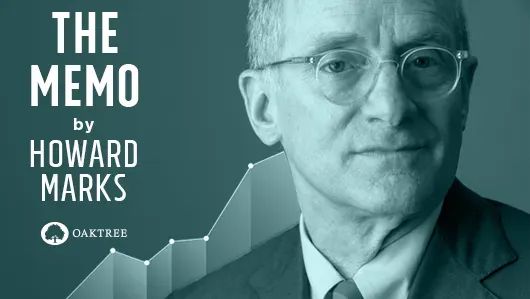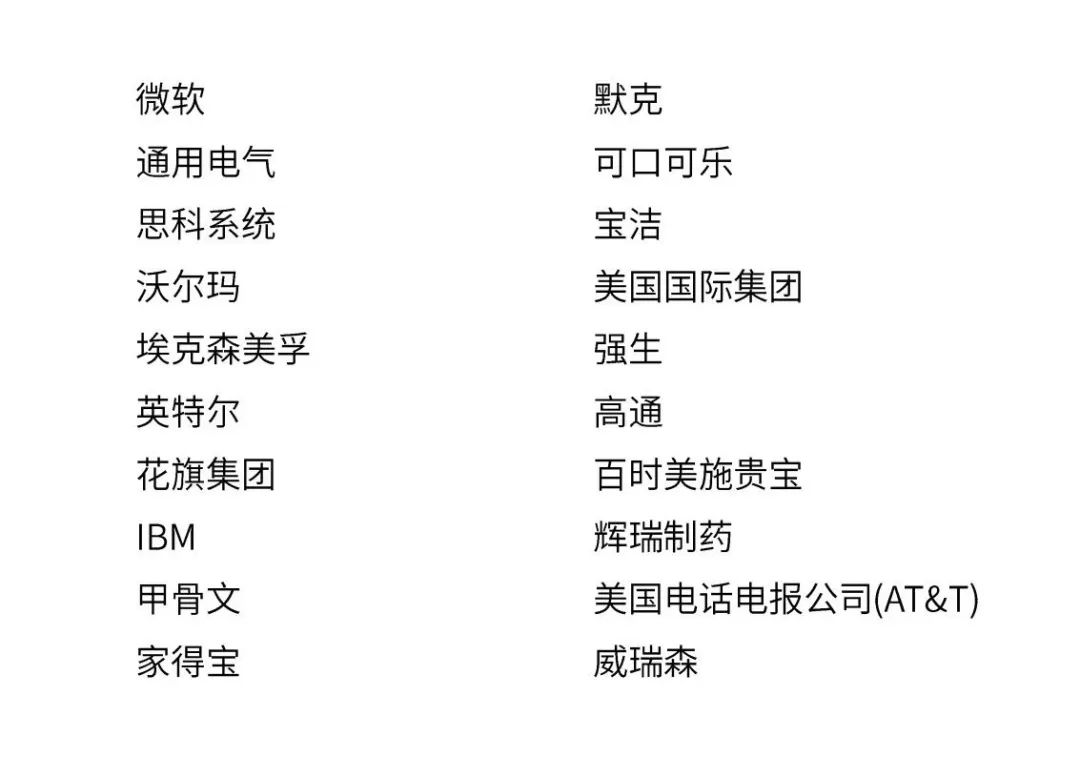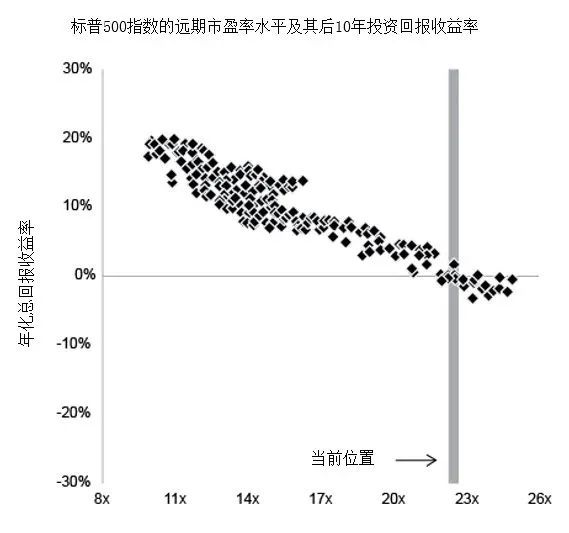
编者按
霍华德·马克斯,橡树资本联合创始人,著有《周期》、《投资最重要的事》。他从上世纪90年代开始撰写的备忘录深受华尔街欢迎,也被他的好朋友、投资大师巴菲特先生所推崇。
在新年的这篇备忘录中,马克斯回应了“美股有泡沫吗?”,也回顾了25年前的互联网科技泡沫,他说:
重要的不是你买了什么,而是你付出了什么价格。
好的投资不在于买好的东西,而在于买得好。
不存在一种好到价格从来都不存在“高估”风险的资产,也鲜有一种坏到价格从来都不存在“低估”机会的资产。
这些观点,历久弥新,下面为大家转载备忘录原文。
On Bubble Watch
再议泡沫
霍华德·马克斯
Exactly 25 years ago today, I published the first memo that brought a response from readers (after having written for almost ten years without receiving any). The memo was called , and the subject was the irrational behavior I thought was taking place with respect to tech, internet, and e-commerce stocks. The memo had two things going for it: it was right, and it was right fast. One of the first great investment adages I learned in the early 1970s is that “being too far ahead of your time is indistinguishable from being wrong.” In this case, however, I wasn’t too far ahead.
就在25年前的今天,我发表的备忘录第一次收到了读者回复(在此之前我已写了将近10年的备忘录,但从未收到任何回复)。那篇备忘录名为《网络科技泡沫》,主题是我认为在科技股、互联网股和电子商务股中正在发生的非理性的投资行为。该备忘录有两个可圈可点之处:它说对了,而且很快得到了印证。我在1970年代初学到的首个伟大投资格言之一是“过于超前与做错,两者很难区分”。就这篇备忘录而言,显然我并非太过超前。
This milestone anniversary gives me an occasion to write again about bubbles, a subject that’s very much of interest today. Some of what I write here will be familiar to anyone who read my December memo about the macro picture. But that memo only went to Oaktree clients, so I’m going to recycle here the part of its content that relates to the subject of bubbles.
这个里程碑式的周年纪念日再次勾起我探讨泡沫的想法,而今,泡沫是一个非常吸睛的主题。读过我12月份关于宏观形势的备忘录的人应该对我在这里写的一些内容不会陌生。但那份备忘录只发给了橡树资本的客户,所以我在这里重复一下其中与泡沫话题相关的部分内容。
Since I’m a credit investor, having stopped analyzing stocks nearly five decades ago, and since I’ve never ventured far into the world of technology, I’m certainly not going to say much about today’s hot companies and their stocks. All of my observations will be generalities, but I’m hopeful they’ll be relevant nonetheless.
众所周知我是一名信用投资者,五十年前开始就不再涉猎股票分析,也未曾对科技领域有过深入研究,因此我也不会对如今的热门公司及其股票品头论足。我所有的观察或许都是泛泛而谈,但我仍希望这些观察具有一定相关性。
In this century’s first decade, investors had the opportunity to participate in – and lose money due to – two spectacular bubbles. The first was the tech-media-telecom (“TMT”) bubble of the late ’90s, which began to burst in mid-2000, and the second was the housing bubble of the mid-aughts, which gave rise to (a) extending mortgages to sub-prime borrowers who couldn’t or wouldn’t document income or assets, (b) the structuring of those loans into levered, tranched mortgage-backed securities, and consequently (c) massive losses for investors in those securities, especially the financial institutions that had created them and retained some. As a result of those experiences, many people these days are on heightened alert for bubbles, and I’m often asked whether there’s a bubble surrounding the Standard & Poor’s 500 and the handful of stocks that have been leading it.
在二十一世纪头十年,投资者有机会参与,甚至因此蒙受损失,两个巨大的泡沫。第一个是二十世纪90年代末兴起并在千禧年年中破裂的科技、媒体及电信(“TMT”)泡沫;第二个在这段时期中间点产生的房地产泡沫。它导致了:(1)向无法或不愿提供收入或资产证明的次级借款人发放房地产抵押贷款;(2)将这些贷款证券化为含有杠杆的、分层抵押支持证券,并最终导致(3)该类证券投资者,特别是创造了这些证券并持有其中部分的金融机构,蒙受了重大损失。顾及这些经历,如今许多人都对泡沫高度警惕。我就经常被问到,标准普尔500股票指数和少数几只领涨的股票是否存在泡沫。
The seven top stocks in the S&P 500 – the so-called “Magnificent Seven” – are Apple, Microsoft, Alphabet (Google’s parent), , Nvidia, Meta (owner of Facebook, WhatsApp, and Instagram), and Tesla. I’m sure I don’t have to go into detail regarding the performance of these stocks; everyone’s aware of the phenomenon. Suffice it to say that a small number of stocks have dominated the S&P 500 in recent years and have been responsible for a highly disproportionate share of its gains. A chart from Michael Cembalest, chief strategist at J.P. Morgan Asset Management, shows that:
标普500的七大个股——即所谓的“美股七雄(“Magnificent Seven”)”——分别为苹果、微软、Alphabet(谷歌的母公司)、亚马逊、英伟达、Meta(Facebook、WhatsApp和Instagram的所有者)和特斯拉。这些股票的表现有目共睹,无需我多言。概括来说,在过去几年里少数几只股票主导了标普500的走势,并在其涨幅中占据极高的比例。摩根资产管理首席策略师Michael Cembalest的一张图表显示:
the market capitalization of the seven largest components of the S&P 500 represented 32-33% of the index’s total capitalization at the end of October;
截至2024年10月底,标普500七大成分股的市值占该指数总市值的32-33%;
that percentage is roughly double the leaders’ share five years ago; and
该比例约为五年前龙头股占比的两倍;以及
prior to the emergence of the “Magnificent Seven,” the highest share for the top seven stocks in the last 28 years was roughly 22% in 2000, at the height of the TMT bubble.
在“美股七雄”兴起之前,过去28年中前七大个股的最高占比是2000年正值TMT泡沫高潮时的约22%。
It’s also important to note that at the end of November, U.S. stocks represented over 70% of the MSCI World Index, the highest percentage since 1970 according to another Cembalest chart. Thus, it’s clear that (a) U.S. companies are worth a lot compared to the companies in other regions and (b) the top seven U.S. stocks are worth a heightened amount relative to the rest of U.S. stocks. But is it a bubble?
同样值得注意的是,根据Michael Cembalest的另一张图表,截至2024年11月底,美国股票在MSCI世界指数中所占比重超过70%,为自1970年以来的最高水平。因此,明显可见(1)与其他地区的公司相比,美国公司的价值很高;及(2)前七大美股的市值高于其余美股。但这就是泡沫吗?
01
What Is a Bubble?
何谓泡沫?
Investment lingo comes and goes. My young Oaktree colleagues use a lot of terms these days for which I have to request translation. But “bubble” and “crash” have been in the financial lexicon for as long as I’ve been in the investment business, and I imagine they’ll remain there for generations to come. Today, the mainstream media uses them broadly, and people seem to consider them to be subject to objective definition. But for me, a bubble or crash is more a state of mind than a quantitative calculation.
投资术语日新月异。如今橡树资本的年轻同事使用了很多我也需借助“翻译”才能理解的投资术语。但是,自从我投身投资事业以来,“泡沫”和“崩盘”这两个金融词汇就一直如影随形,我想在未来的几代人中它们也会一直存在。如今,主流媒体广泛使用它们,人们似乎认为它们可以被客观地定义。但在我看来,泡沫或崩盘与其说是一种量化计算,不如说是一种心理状态。
In my view, a bubble not only reflects a rapid rise in stock prices, but it is a temporary mania characterized by – or, perhaps better, resulting from – the following:
我认为,泡沫不仅反映股价的快速上涨,而且是一种具有以下特征的暂时性狂热,或者更贴切的说,是由以下原因引起的暂时性狂热:
highly irrational exuberance (to borrow a term from former Federal Reserve Chair Alan Greenspan),
高度非理性繁荣(借用前美联储主席艾伦·格林斯潘的话),
outright adoration of the subject companies or assets, and a belief that they can’t miss,
对标的公司或资产的彻底崇拜,以及笃信不能错过,
massive fear of being left behind if one fails to participate (‘‘FOMO’’), and
踏空的巨大恐惧(“FOMO,错失恐惧症”),以及
resulting conviction that, for these stocks, “there’s no price too high.”
因而确信这些股票“价格再高也不为过”。
“No price too high” stands out to me in particular. When you can’t imagine any flaws in the argument and are terrified that your officemate/golf partner/brother-in-law/competitor will own the asset in question and you won’t, it’s hard to conclude there’s a price at which you shouldn’t buy. (As Charles Kindleberger and Robert Aliber observed in the fifth edition of Manias, Panics, and Crashes: A History of Financial Crises, “there is nothing so disturbing to one’s well-being and judgment as to see a friend get rich.”)
“价格再高也不为过”尤其让我印象深刻。当你无法想象论据中的任何缺陷,并害怕你的同事/高尔夫球伴/姐夫/竞争对手将持有你并不持有的资产时,你就很难得出结论说你不应该以某个价格购买。正如查尔斯·金德尔伯格和罗伯特·阿利伯在《疯狂、惊恐和崩溃——金融危机史》(第五版)中所指出,“没有比看到自己的朋友变有钱,更能影响思考与判断的”。
So, to discern a bubble, you can look at valuation parameters, but I’ve long believed a psychological diagnosis is more effective. Whenever I hear “there’s no price too high” or one of its variants – a more disciplined investor might say, “of course there’s a price that’s too high, but we’re not there yet” – I consider it a sure sign that a bubble is brewing.
所以,要辨别泡沫,投资者虽然可以观察估值参数,但我一直认为心理诊断更为有效。每当我听到“价格再高也不为过”或类似说法(更严谨的投资者可能会说:“当然会有价格过高的时候,但我们还没到那一步”)时,我就认为这是泡沫正在酝酿的明确信号。
Roughly fifty years ago, an elder gave me the gift of one of my favorite maxims. I’ve written about it several times in my memos, but in my opinion, I can’t do so often enough. It’s “the three stages of the bull market”:
大约五十年前,一位长者送了一句我最喜欢的格言。我多次在备忘录里提过这句格言,但在我看来,提及得再频繁都不为过。那就是“牛市的三个阶段”:
The first stage usually comes on the heels of a market decline or crash that has left most investors licking their wounds and highly dispirited. At this point, only a few unusually insightful people are capable of imagining that there could be improvement ahead.
第一阶段通常是在让大多数投资者舔舐伤口且情绪极度低落的市场下跌或崩盘之后。此时,只有少数极具洞察力的人才能够想象未来可能会有改善。
In the second stage, the economy, companies, and markets are doing well, and most people accept that improvement is actually taking place.
在第二阶段,经济、公司和市场都表现良好,且大多数人都认为情况确实在改善。
In the third stage, after a period in which the economic news has been great, companies have reported soaring earnings, and stocks have appreciated wildly, everyone concludes that things can only get better forever.
在第三阶段,经历一段经济消息都非常不错、企业盈利飙升以及股票大幅上升的期间后,每个人都认为事情只会变得更好。
The important inferences aren’t with regard to economic or corporate events. They involve investor psychology. It’s not a matter of what’s happening in the macro world; it’s how people view the developments. When few people think there can be improvement, security prices by definition don’t incorporate much optimism. But when everyone believes things can only get better forever, it can be hard to find anything that’s reasonably priced.
重要的推论与经济或企业活动无关,它们往往与投资者的心理相关。这不是宏观世界发生了什么的问题,而是人们如何看待事态发展的问题。当很少有人认为情况会好转的时候,证券价格定然不会反映多少乐观情绪。但是,当每个人都认为事情只会变得更好时,就很难找到价格合理之物。
Bubbles are marked by bubble thinking. Perhaps for working purposes we should say that bubbles and crashes are times when extreme events cause people to lose their objectivity and view the world through highly skewed psychology – either too positive or too negative. Here’s how Kindleberger put it in the first edition of Manias, Panics, and Crashes:
泡沫以泡沫思维为标记。或者处于工作目的,我们应该说,泡沫和崩盘是极端事件导致人们失去客观性并通过高度扭曲的心理看待世界的时候——要么过于正面,要么过于负面。以下为金德尔伯格在《疯狂、惊恐和崩溃》(第一版)给出的说法:
. . . As firms or households see others making profits from speculative purchases and resales, they tend to follow. When the number of firms and households indulging in these practices grows larger, bringing in segments of the population that are normally aloof from such ventures, speculation for profit leads away from normal, rational behavior to what have been described as “manias” or “bubbles.” The word “mania” emphasizes the irrationality; “bubble” foreshadows the bursting. (Emphasis added)
……当企业或家庭看到其他人正在通过投机性买入并转售获利时,他们往往会跟随。当越来越多的企业和家庭沉溺于这些行为无法自拔,进而把在正常情况下会远离这种冒险行为的群体引入其中时,投机逐利会将正常而理性的行为引向所谓的“疯狂”或“泡沫”。“疯狂”一词强调非理性;“泡沫”则预示着破裂。(粗体部分表示强调)
For me, it’s psychological extremeness that marks a bubble. Often, as Kindleberger indicates, it can be inferred from widespread participation in the investment fad of the moment, especially among non-financial types. Legend has it that J.P. Morgan knew there was a problem when the person shining his shoes started giving him stock tips. My partner John Frank says he saw it in 2000, when he heard the dads at his son’s soccer game bragging about the tech stocks they owned, and again in 2006, when a Las Vegas cab driver told him about the three condos he’d purchased. When Mark Twain purportedly said, “history doesn’t repeat itself, but it often rhymes,” it’s this kind of thing he was talking about.
在我看来,泡沫以投资心理走向极端为标记。正如金德尔伯格所指出,这可以从普遍参与当下的投资热潮中推断出来,尤其是在非金融人士中。传说,当约翰·皮尔庞特·摩根的擦鞋匠开始给他荐股时,就知道出了问题了。我的合伙人John Frank说,他在2000年就发现了这个问题,当时他在儿子的足球比赛现场听到父亲们吹嘘他们持有的科技股;然后在2006年听到一位拉斯维加斯出租车司机告诉他买了三套公寓时又看到了泡沫。马克·吐温曾言:“历史不会重复,却惊人地相似”,他说的就是这种情况。
02
The New, New Thing
全新的事物
If bubble thinking is irrational, what is it that permits investors to get away from rational thinking, like the thrust of a rocket ship that breaks free of the limits imposed by gravity and attains escape velocity? There’s a simple answer: newness. This phenomenon relies on another time-honored investment phrase, “this time is different.”
如果泡沫思维是非理性的,那么是什么让投资者脱离理性思维,仿佛火箭飞船的推力突破重力的限制达到逃逸速度一般?答案很简单:新鲜感。这种现象依赖于另一个久负盛名的投资习语:“这次不一样”。
Bubbles are invariably associated with new developments. There were bubbles in the Nifty Fifty stocks in the 1960s (more on them just below), disc drive companies in the 1980s, TMT/internet stocks in the late 1990s, and sub-prime mortgage-backed securities in 2004-06. These relatively recent manias followed in the tradition of ones like (a) the 1630s craze in Holland over recently introduced tulips and (b) the South Sea Bubble in 1720 England concerning the riches that were sure to ensue from a trading monopoly that the Crown had awarded to the South Sea Company.
泡沫总是与新的事态发展有关。历史上的泡沫有:1960年代的“漂亮五十”股票(下文将详细介绍)、1980年代的磁盘驱动器公司、1990年代末的TMT/互联网股票和2004-06年的次级抵押贷款支持证券。这些相对近期的疯狂沿袭了以下更为古老的泡沫:(1)1630年代荷兰对新近引进郁金香的狂热;以及(2)1720年发生在英格兰的涉及到王室授予南海公司的贸易垄断特权下必然带来财富的南海泡沫。
In normal circumstances, if an industry’s or a country’s securities are attracting unusually high valuations, investment historians are able to point out that, in the past, those stocks had never sold at more than an x% premium over the average, or some similar metric. In this way, attention to history can serve as a tether, keeping a favored group grounded on terra firma.
在正常情况下,如果一个行业或一个国家的证券获得异常关注而出现高估值,投资领域的“历史学家”就常常指出,以往这些股票的溢价从未超过平均水平或类似指标的x%。通过这种方式,对历史的关注就像一根绳索,将受青睐的群体牢牢地系在地面上。
But if something’s new, meaning there is no history, then there’s nothing to temper enthusiasm. After all, it’s owned by the brightest people – the ones who are showing up in the headlines and on TV – and they’ve made a fortune. Who’s willing to throw a wet blanket over that party or sit out that dance?
但如果是新的事物,则意味着无史可查,那么投资热情就无从抑制了。毕竟,新事物由最聪明的人(出现在头条新闻和电视上的人)拥有并大赚特赚。谁又愿意向派对泼冷水或者不下场狂舞呢?
The explanation often lies in Hans Christian Andersen’s story The Emperor’s New Clothes. Con men sell the emperor an allegedly gorgeous suit of clothes that only intelligent people can see. But in actuality there is no suit. When the emperor parades around town naked, the citizens are afraid to say they don’t see a suit, since that would mark them as unintelligent. This goes on unchecked until a young boy steps out of the crowd and – in his naivete – points out that the emperor has no clothes. Most people would rather go along with a shared delusion that’s making investors buckets of money than say something to the contrary and appear to be dummies. When a whole market or a group of securities is blasting off and a specious idea is making its adherents rich, few people will risk calling it out.
汉斯·克里斯汀·安徒生的故事《皇帝的新衣》往往能解释这个问题。骗子们向皇帝兜售一套声称只有聪明人才能看得见的华丽衣服,但实际上并没有衣服。当皇帝在城镇裸体巡游时,市民都不敢说他们没有看到衣服,因为这会让人觉得他们不聪明。这种情况一直持续下去,直到一个小男孩从人群中走出来,天真地指出皇帝没有穿衣服。大多数人宁愿接受一种让投资者赚大钱的共同错觉,也不愿说些相反的话,让自己看起来像个傻瓜。当整个市场或一类证券被炒得沸沸扬扬,一个似是而非的想法正在让其信徒赚得盆满钵满时,很少有人会冒险揭穿它。
03
My Baptism Under Fire
我的战火洗礼
They say experience is what you got when you didn’t get what you wanted, and I got my most formative experience at the very beginning of my career. As many of my memo readers know, I joined the equity research department at First National City Bank (now Citi) in September 1969. As was the case with most of the so-called “money-center banks,” Citi invested mainly in the “Nifty Fifty”– the stocks of the best and fastest-growing companies in America. These companies were considered to be so good that (a) nothing bad could ever happen and (b) there was no price too high for their stocks . . . literally.
人们常说,所谓经验,就是你没能获得你想要的东西时所得到的东西,而我在职业生涯的初期就获得了对我影响最大的经验。读过我备忘录的人大多知道,我在1969年9月加入了第一国民城市银行(现为花旗银行)的股票研究部。和大多数所谓的“货币中心银行”一样,花旗主要投资于“漂亮五十”——美国最好且发展最快的公司股票。投资者认为这些公司非常好,(1)断然不会发生任何不好之事,且(2)对他们的持股来说价格再高也不为过……
Three factors contributed to investors’ fascination with these stocks. First, the U.S. economy grew strongly in the post-World War II period. Second, these companies benefitted from their involvement with areas of innovation such as computers, drugs, and consumer products. And third, they represented the first wave of “growth stocks,” a new investment style that separately became a fad in itself. The Nifty Fifty were the object of the first big bubble in roughly 40 years, and since there hadn’t been one for so long, investors had forgotten what a bubble looks like. As a result of the popularity that was conferred on them, if you bought these stocks on the day I started work and held them tenaciously for five years, you lost well over 90% of your money . . . in the best companies in America. What happened?
让投资者迷恋这些股票的因素有三个。第一,美国经济在二战后期间增长强劲。第二,这些股票参与了各个创新领域(如计算机、药品和消费品)并因此受益。第三,这些股票代表了第一波“成长股”,这是一种新的投资风格,其本身已成为一种时尚。“漂亮五十”是过去40年来的首个大型泡沫,而且由于太久没有出现泡沫,投资者已经忘记泡沫长什么样子了。由于这些股票在当时备受青睐,如果你在我开始工作的那天就买入这些股票,然后坚持持有五年,那么你将在美国最好的公司上亏损90%以上的资金……到底发生了什么?
The Nifty Fifty had been put on a pedestal, and investors get hurt when something falls from it. The stock market as a whole declined by about half in 1973-74. And it turned out these stocks had been selling at prices that actually were too high; in many cases, their price/earnings ratios fell from the range of 60 to 90 to the range of 6 to 9 (that’s the easy way to lose 90%). Further, bad things actually did happen to several of the companies in fundamental terms.
“漂亮五十”被捧上了神坛,一旦从神坛上跌落,受伤的自然是投资者了。整个股票市场在1973-1974年间下跌了大约一半。事实证明,这些股票的售价确实过高;大部分股票的市盈率从60到90的区间跌至6到9的区间(这便是轻松亏损90%的“方法”)。此外,确实有几家公司遇到基本面变差的情况。
My early brush with a genuine bubble caused me to formulate some guiding principles that carried me through the next 50-odd years:
在从业初期就能与真实的投资泡沫的接触促使我制定了一些原则,并指导我走过之后50多年的风风雨雨:
It’s not what you buy, it’s what you pay that counts.
买什么不是重点,重点在于你为此付出了多少(价格)。
Good investing doesn’t come from buying good things, but from buying things well.
好的投资不在于买好的东西,而在于买得好。
There’s no asset so good that it can’t become overpriced and thus dangerous, and there are few assets so bad that they can’t get cheap enough to be a bargain.
不存在一种好到价格从来都不存在“高估”而风险的资产,也鲜有一种坏到价格从来都不存在“低估”机会的资产。
04
Things Can Only Get Better
事情只会变得更好
The bubbles I’ve lived through have all involved innovations, as I noted above, and many of those were either overestimated or not fully understood. The attractions of a new product or way of doing business are usually obvious, but the potholes and pitfalls are often hidden and only discovered in trying times. A new company may completely outclass its predecessors, but investors who by definition lack experience in this new field often fail to grasp that even a bright newcomer can be supplanted. The disrupters can be disrupted, whether by skillful competitors or even newer technologies.
我经历过的泡沫,如前所述,全都与创新有关,而大多创新要么被高估,要么未得到充分理解。一种新产品或营商之道通常会展现出显而易见的吸引力,但其中的陷阱和风险往往难以发现,甚至要到困难时期才会被发现。新的公司固然有可能完全超越其前辈,但在这一新领域缺乏经验的投资者往往无法理解,就算是前途光明的新公司也可能会被取代。颠覆者也有可能被颠覆,要么被技胜一筹的竞争者颠覆,要么被更先进的技术所颠覆。
In my early decades in business, technology seemed to evolve gradually. Computers, drugs, and other innovative products improved a little at a time. But in the 1990s, innovation came in a big rush. When Oaktree was founded in 1995, I insisted that I could get by with just WordPerfect for word processing and Lotus 1-2-3 for spreadsheets. But when we moved to our current office in 1998, I threw in the towel and let our IT team install e-mail and the internet (and, of course, WordPerfect gave way to Word, and Lotus 1-2-3 to Excel). At the time, investors were sure “the internet will change the world.” It certainly looked that way, and that assumption prompted tremendous demand for everything internet-related. E-commerce stocks went public at seemingly high prices and then tripled the first day. There was a real goldrush.
在我事业生涯的前几十年,科技似乎是以渐进的方式发展。计算机、药品和其他创新产品则以平稳节奏前进。但进入1990年代,创新层出不穷。1995年橡树资本成立时,我坚持认为,处理文字只能靠WordPerfect软件,电子表格只有Lotus 1-2-3软件。但是当我们在1998年搬到目前的办公室时,我认输了,并让IT团队安装了电子邮件系统和互联网浏览器(当然,WordPerfect让位于Word以及Lotus 1-2-3让位于Excel)。当时,投资者确信“互联网将改变世界”。看起来确实是这样,而该假设催生了对各种互联网相关事物的巨大需求。电子商务股以看似很高的价格挂牌上市,然后第一天就翻了三倍。随之而来的是一场真正的淘金热潮。
There’s usually a grain of truth that underlies every mania and bubble. It just gets taken too far. It’s clear that the internet absolutely did change the world – in fact, we can’t imagine a world without it. But the vast majority of internet and e-commerce companies that soared in the late ’90s bubble ended up worthless. When a bubble burst in my early investing days, The Wall Street Journal would run a box on the front page listing stocks that were down by 90%. In the aftermath of the TMT Bubble, they’d lost 99%.
每一轮狂热和泡沫背后通常都潜藏着真理,只是这种合理性被过度放大了。显然,互联网确实改变了世界——事实上,我们无法想象一个没有互联网的世界。但是,绝大多数在90年代末的泡沫中狂飙的互联网和电子商务公司最终都变得一文不值。在我投资生涯早期的一次泡沫破裂期间,《华尔街日报》会在头版刊登一个栏目,列出下跌幅度达90%的股票。在TMT泡沫后的一段时间里,那些公司的跌幅达到了99%。
When something is on the pedestal of popularity, the risk of a decline is high. When people assume – and price in – an expectation that things can only get better, the damage done by negative surprises is profound. When something is new, the competitors and disruptive technologies have yet to arrive. The merit may be there, but if it’s overestimated it can be overpriced, only to evaporate when reality sets in. In the real world, trees don’t grow to the sky.
当某样事物被追捧至顶峰的时候,其跌落的风险会很高。当人们假设并预期事情只会变得更好时,意料之外的负面情况所造成的伤害将会刻骨铭心。在某样事物刚刚兴起时,竞争对手和颠覆性科技尚未浮现。可能其中确实存在优点,但如果被高估,价格就会变得过高,当大家认识到现实后,一切就烟消云散了。在现实世界中,树木是长不到天上去的。
The foregoing discussion centered on the risk of overestimating fundamental strength. But optimism surrounding the power and potential of the new thing often causes the error to be compounded through the assignment of too high a stock price.
上文集中讨论了高估基本面能力所带来的风险。但是对新事物蕴含的力量和潜力所持的乐观态度往往会导致这项事物被赋予过高的股票价值,从而让错误变得复杂。
As mentioned above, for something new, there by definition is no historical indicator of what an appropriate valuation might be.
如前所述,对于新事物,必然不存在可衡量适当估值的历史指标。
Further, the companies’ potential hasn’t yet been turned into steady-state profits, meaning the thing that’s being valued is conjectural. In the TMT Bubble, the companies didn’t have earnings, so p/e ratios were out. And as startups, they often didn’t have revenues to value. As a result, new metrics were invented, and trusting investors ended up paying a multiple of “clicks” or “eyeballs,” regardless of whether these measurables could be turned into revenues and profits.
此外,这些公司的潜力尚未转化为稳定的利润,意味着所被估值之物仅为揣测。在TMT泡沫中,这些公司并无盈利,因此无市盈率可查。此外,作为初创公司,他们往往没有收入可供估值。因此,新指标应运而生,投资者盲目追捧“点击率”或“观看率”作为价值标准,而忽视这些指标是否能够真正转化为收入和利润。
Since bubble participants can’t imagine there being any downside, they tend to award valuations that assume success.
由于泡沫参与者无法想象会有任何不利情况,他们所赋予的估值往往是针对假设取得成功的情况。
In fact, it’s not infrequent for investors to treat all contenders in a new field as likely to succeed, whereas in reality only a few may thrive, or perhaps even survive.
事实上,投资者认为某个新兴领域的所有竞争者都有可能成功,这种心态并不少见,但现实往往是,只有少数几家公司能够茁壮成长,甚至存活下来。
Ultimately, with a really hot new thing, investors can adopt what I call “a lottery ticket mentality.” If a successful startup in a hot field can return 200x, it’s mathematically worth investing in even if it’s only 1% likely to succeed. And what doesn’t have a 1% likelihood of success? When investors think this way, there are few limits on what they’ll support or the prices they’ll pay.
最后,投资者可能对极为热门的新事物采取我所说的“彩票心态”。如果在热门领域中,一家成功的初创公司能够提供200倍的回报,那么从数学上来讲,即使成功的概率只有1%,也值得投资。那么,有什么投资会连1%的成功概率都没有呢?如果投资者如此想,他们支持的事物或他们愿意支付的价格就几乎没有上限。
Obviously, investors can get caught up in the race to buy the new, new thing. That’s where the bubble comes in.
显然,投资者会陷入竞逐买入新事物的泥潭中。这就是泡沫的来源。
05
What’s the Appropriate Price to Pay for a Bright Future?
光明未来的合理定价是多少?
If there’s a company for sale that will make $1 million next year and then shut down, how much would you pay for it? The right answer is a little less than $1 million, so that you’ll have a positive return on your money.
如果有一家明年赚完100万美元就倒闭的公司待售,你会为这家公司支付多少钱?正确的答案是略低于100万美元,唯有如此,你的投资才能获得正回报。
But stocks are priced at “p/e multiples” – that is, multiples of next year’s earnings. Why? Because presumably they won’t earn profits for just one year; they’ll go on making money for many more. When you buy a stock, you buy a share of the company’s earnings every year into the future. The price of the S&P 500 has averaged roughly 16 times earnings in the post-World War II period. This is typically described as meaning “you’re paying for 16 years of earnings.” It’s actually more than that, though, because the process of discounting makes $1 of profit in the future worth less than $1 today. The current value of a company is the discounted present value of its future earnings, so a p/e ratio of 16 means you’re paying for more than 20 years of earnings (depending on the interest rate at which future earnings are discounted).
但是,股票是按“市盈率”(即次年盈利的倍数)定价的。为什么?因为很有可能公司不会只盈利一年;公司将会在后续的很多年继续盈利。当你买入一只股票时,你买入的是该公司未来每年盈利的一部分。第二次世界大战后,标普500的平均市盈率约为16倍,即,也就是所谓“你正在为16年的盈利买单”。但实际上远不止于此,因为贴现算法使得未来1美元的利润价值低于今天的1美元。一家公司的当前价值若是其未来盈利的贴现现值的话,那么16倍市盈率实际意味着你正在为超过20年的盈利买单(取决于贴现未来盈利的利率)。
In bubbles, hot stocks sell for considerably more than 16 times earnings. Remember the 60 to 90 times for the Nifty Fifty! Investors in 1969 were paying for companies’ earnings – even after giving them credit for significant earnings growth – many decades into the future. Did they do so consciously and analytically? Not that I recall. Investors thought of a p/e ratio as just a number . . . if they thought about it at all.
而且在泡沫时期,热门股票的市盈率远高于16倍。当年的“漂亮五十”的市盈率达60至90倍!就算他们真的将会如预期那样出现显著的盈利增长,但是1969年的投资者正是在为未来“几十年”的公司盈利买单。他们是有意识、有分析地这样做的吗?我记得并没有。投资者认为市盈率只是一个数字…如果他们真有想过市盈率的话。
Today’s S&P-leading companies are, in many ways, much better than the best companies of the past. They enjoy massive technological advantages. They have vast scale, dominant market shares, and thus above average profit margins. And since their products are based on ideas more than metal, the marginal cost of producing an additional unit is low, meaning their marginal profitability is unusually high.
如今标普指数的龙头公司在很多方面都远优于以往最好的公司。这些公司享有巨大的科技优势,并拥有庞大的规模,占主导地位的市场份额以及超越均值的盈利水平。此外,由于它们的产品更多是基于创意而非实体原材料,生产额外单位的边际成本很低,换言之,边际利润率非常高。
The further good news is that today’s leaders don’t trade at the p/e ratios investors applied to the Nifty Fifty. Perhaps the sexiest of the seven is Nvidia, the leading designer of chips for artificial intelligence. It’s current multiple of future earnings is in the low 30s, depending on which earnings estimate you believe. While double the average post-war p/e on the S&P 500, that’s cheap compared to the Nifty Fifty. But what does a multiple in the 30s imply? First, that investors think Nvidia will be in business for decades to come. Second, that its profits will grow throughout those decades. And third, that it won’t be supplanted by competitors.
In other words, investors are assuming Nvidia will demonstrate persistence.
而且,如今的龙头公司的市盈率并没有漂亮五十那般高。在“美股七雄”中,最诱人的可能是人工智能芯片的领先设计商英伟达。该公司当前的未来市盈率仅为30出头,这取决于你采取哪一种盈利估计方法。虽然是战后标普500指数平均市盈率的两倍,但仍远低于漂亮五十。但是,30倍市盈率意味着什么呢?第一,投资者认为英伟达将在未来几十年持续经营。第二,该公司的利润将在这几十年内持续增长。第三,该公司不会被竞争对手所取代。换言之,投资者正在假设英伟达将能够持久长青。
But persistence isn’t easily achieved, especially in high-tech fields where new technologies can arise and new competitors can leapfrog incumbents. It’s worth noting, for example, that only about half the Nifty Fifty (as enumerated by Wikipedia – there is no agreed-on list) are in the S&P 500 today (that figure undoubtedly looks worse than the reality, since mergers and acquisitions caused some of the old names to disappear, not failures). Leading lights of 1969 that are missing from the S&P 500 today include Xerox, Kodak, Polaroid, Avon, Burroughs, Digital Equipment, and my favorite, Simplicity Pattern (how many people make their own clothing these days?).
但是,持久长青不容易做到,特别是在新科技层出不穷、新竞争对手可能超越现有企业的高科技领域。举例而言,值得注意的是,如今还留在标普500的漂亮五十(漂亮五十仅援引维基百科所列举,并无公认名单)只有一半左右(该数字看起来无疑比现实更为糟糕,因为导致一些“老字号”消失的是并购活动,而非经营失败)。如今标普500中已经消失的1969年的龙头企业包括施乐、柯达、宝丽来、雅芳、伯勒斯、Digital Equipment以及我最喜欢的Simplicity Pattern(现在有多少人自己做衣服?)。
Another indication of how hard it is to persist can be seen in the names of the top twenty S&P 500 companies. At the beginning of 2000, according to , these twenty companies were the most heavily represented in the index:
此外,从标普500的前二十大公司名字可见,持久长青到底有多难。根据的数据,2000年初,以下20家公司在指数中的占比最高:

At the beginning of 2024, however, only six of them were still in the top twenty:
然而,2024年年初,只有其中六家公司仍在前二十大之列:

Importantly, of today’s Magnificent Seven, only Microsoft was in the top twenty 24 years ago.
尤其,在如今的美股七雄中,只有微软是24年前的前二十大公司之一。
In bubbles, investors treat the leading companies – and pay for their stocks – as though the firms are sure to remain leaders for decades. Some do and some don’t, but change seems to be more the rule than persistence.
在泡沫期间,投资者愿意为龙头公司的高昂股票价格买单,他们认为这些龙头企业定然会几十年如一日地占据领先地位。但是,有些公司能做到,有些公司做不到。变化才是永恒不变的规则,而非持久长青。
06
Whole Markets
整个市场
The greatest bubbles usually originate in connection with innovations, mostly technological or financial, and they initially affect a small group of stocks. But sometimes they extend to whole markets, as the fervor for a bubble group spreads to everything.
最大的泡沫通常发源于创新领域、而且多半与科技方面或金融方面的创新有关,最初只有一小部分股票受到影响。但有时会扩展到整个市场,因为对某一泡沫群体的狂热会蔓延到一切。
In the 1990s, the S&P 500 was borne aloft by (a) the continuing decline of interest rates from their inflation-fighting peak in the early 1980s and (b) the return of investor enthusiasm for stocks that had been lost in the traumatic ’70s. Technological innovation and the rapid earnings growth of the high-tech companies added to the excitement. And an upswing in the popularity of stocks was reinforced by new academic research showing there had never been a long period in which the S&P 500 failed to outperform bonds, cash, and inflation. The combination of these positive factors caused the annual return on the index to average more than 20% for the decade. I’ve never seen another period like it.
1990年代,在(1)利率从1980年代初对抗通货膨胀的峰值持续下降;及(2)投资者因70年代的惨痛经历而对股票丧失的热情重燃的推动下,标普500一路走高。科技创新和高科技公司的快速盈利增长也为市场的激昂情绪火上浇油。当时的学术研究还指出标普500从来没有出现过长时间跑输债券、现金和通货膨胀的情况,这进一步助推了股票受欢迎程度的上升态势。在上述积极因素的综合影响下,标普500指数在那十年实现了超过20%的年化回报率,这种时代是我前所未见的。
I always say the riskiest thing in the world is the belief that there’s no risk. In a similar vein, heated buying spurred by the observation that stocks had never performed poorly for a long period caused stock prices to rise to a point from which they were destined to do just that. In my view, that’s George Soros’s investment “reflexivity” at work. Stocks were tarred in the bursting of the TMT Bubble, and the S&P 500 declined in 2000, 2001, and 2002 for the first three-year decline since 1939, during the Great Depression. As a consequence of this poor performance, investors deserted stocks en masse, causing the S&P 500 to have a cumulative return of zero for the more than eleven years from the bubble peak in mid-2000 until December 2011.
我经常说,在这个世界上,最大的风险莫过于认为没有风险。同样地,受股票从未长时间表现不佳的观察所引发的激烈买盘,导致股票价格上升至注定会出现这种情况的点位。在我看来,这是乔治·索罗斯的投资“反身性”在起作用。股票在TMT泡沫破裂时遭受重创,且标普500在2000年、2001年和2002年下跌,为自1939年大萧条以来的首次连续三年下跌。受这种糟糕表现影响,投资者争相抛售股票,导致标普500从2000年中泡沫见顶后,至2011年12月止逾十一年期间的累计回报率为零。
Lately, I’ve been repeating a quote I attribute to Warren Buffett: “When investors forget that corporate profits grow about 7% per year they tend to get into trouble.” What this means is that if corporate profits grow at 7% a year and stocks (which represent a share in corporate profits) appreciate at 20% a year for a while, eventually stocks will be so highly priced relative to their earnings that they’ll be risky. (I recently asked Warren for a source on the quote, and he told me he never said it. But I think it’s great, so I keep using it.)
最近,我一直在重复沃伦·巴菲特的一句话:“当投资者忘记了企业利润的年增长率约为7%的时候,他们往往会陷入麻烦”。这意味着,如果企业利润每年增长7%,而股票(代表企业利润的一部分)在一段时间内每年涨幅达20%,那么最终股票的市盈率将会过高,以至于产生风险。(我最近请教沃伦·巴菲特这句话的出处,而他告诉我,他从未说过这句话。但我认为这句话很棒,因此我一直引用。)
The point is that when stocks rise too fast – out of proportion to the growth in the underlying companies’ earnings – they’re unlikely to keep on appreciating. Michael Cembalest has another chart that makes this point. It shows that prior to two years ago, there were only four times in the history of the S&P 500 when it returned 20% or more for two years in a row. In three of those four instances (a small sample, mind you), the index declined in the subsequent two-year period. (The exception was 1995-98, when the powerful TMT bubble caused the decline to be delayed until 2000, but then the index lost almost 40% in three years.)
关键点在于,当股票上涨过快(相对发行企业的盈利增长不成比例)时,就不太可能持续升值。Michael Cembalest在另一张图表中阐明了这一点。该图表显示,在两年之前,标普500历史上只有四次连续两年的回报率达到或超过20%。在这四次(注意,这只是一个小样本)中,指数有三次在接下来的两年中出现了回撤。(1995-1998年是个例外——强大的TMT泡沫将回撤推迟到2000年,而在接下来的三年里指数下撤了40%。)
In the last two years, it’s happened for the fifth time. The S&P 500 was up 26% in 2023 and 25% in 2024, for the best two-year stretch since 1997-98. That brings us to 2025. What lies ahead?
过去两年,这种情况第五次出现,标普500在2023年上升26%并在2024年上升25%,可谓是1997-1998年以来的最好两年期表现。然后我们进入了2025年。未来将如何?
The cautionary signs today include these:
如今出现的警示信号包括:
the optimism that has prevailed in the markets since late 2022,
自2022年底以来充斥市场的乐观情绪;
the above average valuation on the S&P 500, and the fact that its stocks in most industrial groups sell at higher multiples than stocks in those industries in the rest of the world,
标普500指数的估值高于平均水平,且大部分行业群组的市盈率高于世界其他地区同类产业中的公司的市盈率;
the enthusiasm that is being applied to the new thing of AI, and perhaps the extension of that positive psychology to other high-tech areas,
对人工智能这一新兴事物的热情,以及这种乐观心态可能会蔓延到其他高科技领域;
the implicit presumption that the top seven companies will continue to be successful, and
默认“美股七雄”将持续取得成功;以及
the possibility that some of the appreciation of the S&P has stemmed from automated buying of these stocks by index investors, without regard for their intrinsic value.
标普500指数的上涨部分源自指数投资者在没有考虑股票内在价值的情况下自动购买这些股票。
Finally, while I’m at it, although it’s not directly related to stocks, I have to mention Bitcoin. Regardless of its merit, the fact that its price rose 465% in the last two years doesn’t suggest an overabundance of caution.
最后,我们来说说比特币,虽然它与股票并不直接相关。抛开比特币的优点不谈,比特币的价格在过去两年上升465%的事实显然不能成为投资者过于谨慎的作证。
I often find that, just as I’m about to release a memo for publication, something comes along that demands inclusion, and it has happened again. On the last day of 2024, I received something from two sources that fits that description:
正如我一直说的,我常常发现,就在我要发布备忘录的时候总会有事情发生,这次也不例外。在2024年的最后一天,我从两个来源收到了符合这一描述的东西:

The graph, from J.P. Morgan Asset Management, has a square for each month from 1988 through late 2014, meaning there are just short of 324 monthly observations (27 years x 12). Each square shows the forward p/e ratio on the S&P 500 at the time and the annualized return over the subsequent ten years. The graph gives rise to some important observations:
这张来自摩根大通资产管理公司的图表,从1988年到2014年底的每个月观察一次并以方块表示,整张图324个月度观察值(27年 x 12)。每个方块代表当时标普500指数的远期市盈率以及随后十年的年化回报率。这张图发人深省:
There’s a strong relationship between starting valuations and subsequent annualized ten-year returns. Higher starting valuations consistently lead to lower returns, and vice versa. There are minor variations in the observations, but no serious exceptions.
期初估值与随后十年的年化回报率之间存在强烈关系。较高的期初估值往往导致较低的回报,反之亦然。虽然观察结果存在一些细微差异,但没有严重的例外情况。
Today’s p/e ratio is clearly well into the top decile of observations.
今天的市盈率明显处于观察样本区间的最高十分位数。
In that 27-year period, when people bought the S&P at p/e ratios in line with today’s multiple of 22, they alwaysearned ten-year returns between plus 2% and minus 2%.
在1988年至2014年的27年期间,当投资者以与今天相当的市盈率,即22倍,购买标普500指数时,他们往往只能获得介于正2%和负2%之间的十年回报率。
In November, a couple of leading banks came out with projected ten-year returns for the S&P 500 in the low- to mid-single digits. The above relationship is the reason. It shouldn’t come as a surprise that the return on an investment is significantly a function of the price paid for it. For that reason, investors clearly shouldn’t be indifferent to today’s market valuation.
在11月,几家行业领先的银行发布了标普500指数未来十年的回报率预测,预测值处于中低个位数。上述市盈率估值与投资回报的关系是恰好是注解。投资回报显著取决于投资支付的价格,这并不令人意外。因此,投资者显然不应对当下的股票市场估值漠不关心。
You might say, “making plus-or-minus-2% wouldn’t be the worst thing in the world,” and that’s certainly true if stocks were to sit still for the next ten years as the companies’ earnings rose, bringing the multiples back to earth. But another possibility is that the multiple correction is compressed into a year or two, implying a big decline in stock prices such as we saw in 1973-74 and 2000-02. The result in that case wouldn’t be benign.
你可能会说,“获得正负2%的年化回报并不是世界上最糟糕的事情”,如果股票价格在未来十年保持不变,而公司的盈利水平上升,那么市盈率就会从高估位置回到正常水平,话是没错。但另一种可能性也存在,那就是市盈率可能在一到两年内受到挤压,股票价格将出现大幅下跌,就像我们在1973-1974年和2000-2002年看到的那样。在这种情况下,结果真的很糟糕。
The above are the things to worry about. Here are the counterarguments:
以上是需要担心的事情。接下来是反面论点:
the p/e ratio on the S&P 500 is high but not insane,
标普500的市盈率很高,但并不离谱;
the Magnificent Seven are incredible companies, so their high p/e ratios could be warranted,
“美股七雄”是令人惊叹的优质公司,这些公司的市盈率并不离谱;
I don’t hear people saying, “there’s no price too high;” and
我并未听到人们传出“价格再高也不为过”的言论;以及
the markets, while high-priced and perhaps frothy, don’t seem nutty to me.
市场虽然价格高企,或许还存在泡沫,但在我看来并不疯狂。
As I said at the start of this memo, I’m not an equity investor, and I’m certainly no expert on technology. Thus, I can’t speak authoritatively about whether we’re in a bubble. I just want to lay out the facts as I see them and suggest how you might think about them . . . just as I did 25 years ago.
正如我在本备忘录开篇所说,我并非股票投资者,当然也不是科技方面的专家。因此,我无法就现在是否处于泡沫之中发表权威言论。我只想列出所见事实,并就如何看待这些事实提供建议…就像我25年前所做的那样。
I hope you’ll keep reading for the next 25!
我希望未来25年您还将继续阅读我的备忘录!
January 2, 2025
2025年1月2日
(本文转载于公众号:橡树资本Oaktree Capital)
0
推荐




 京公网安备 11010502034662号
京公网安备 11010502034662号 